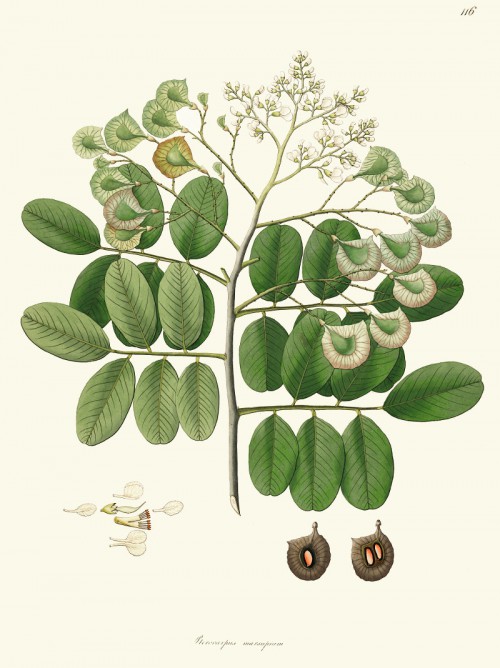Benutzer-Werkzeuge
Pterocarpus marsupium Roxb. - Fabaceae - bija (hindi), East Indian kino, Malabar kino, Andaman padauk, vengai padauk, Bastard-Teak, Malabar Kino Baum
Deciduous tree, up to 30m tall, native to India, Nepal and Sri Lanka.
„Parts of the Indian Kino (heartwood, leaves, flowers) have long been used for their medicinal properties in Ayurveda. The heartwood is used as an astringent and in the treatment of inflammation and diabetes, for which it has been shown to be effective due to its high pterostilbene content.“
https://en.wikipedia.org/wiki/Pterocarpus_marsupium
„Serum lipid levels in rats with hyperlipidemia induced by diet as well as by Triton were determined after oral administration of EtOAc extract of Pterocarpus marsupium heartwood and its flavonoid constituents, marsupsin, pterosupin, and liquiritigenin. Administration of EtOAc extract for 14 consecutive days produced a significant reduction of serum triglyceride, total cholesterol, and LDL- and VLDL-cholesterol levels without any significant effect on the level of HDL-cholesterol.“
[Antihyperlipidemic effect of flavonoids from Pterocarpus marsupium., Jahromi, M.F., Ray, A.B., Chansouria, J.P.N., Journal of Natural Products, Vol.56(7), 1993, 989-994]
„An active constituent of Pterocarpus marsupium, (-)-epicatechin, has been reported to reverse hyperglycemia in alloxan diabetic rats when given before or within 24 hr after the dose of alloxan. However, when doses of (-)-epicatechin (30 mg/kg, i.p., twice daily for 3 days) are begun 92 hr after alloxan, there is no significant difference in blood glucose levels between control and (-)-epicatechin treated rats. These data suggest that, although (-)-epicatechin may protect against alloxan toxicity under certain conditions, the usefulness of (-)-epicatechin appears minimal in the treatment of already established diabetic states.“
[A constituent of Pterocarpus marsupium,(-)-epicatechin, as a potential antidiabetic agent., Sheehan, E.W., Zemaitis, M.A., Slatkin, D.J., Schiff Jr,P.L., Journal of natural products, Vol.46(2), 1983, 232-234]
Preparations of the dried sap (Malabar kino) from the incised bark have been used against diarrhea, intestinal bleeding, and for the treatment of the oral mucosa. Several other species of Pterocarpus (P.angolensis; P.erinaceus; P.indicus; P.santalinus; P.santalinoides) provide resins that are traded as kino (with good or minor quality). 80% of the resin is soluble in cold water, 90% in hot water. „Kino tannic acid“ content is 70-80%.
[Hagers Handbuch der Pharmazeutischen Praxis, Springer 2010]
„The bark of the P. marsupium tree is rough, grey, longitudinally fissured and scaly. Older trees exude a blood-red gum resin. The tree’s heartwood is golden yellow, while its sapwood is pale yellow to white in color…
Some medicinal uses of P. marsupium as mentioned in ayurveda: Leaf - External application for boils, sores and skin diseases, stomach pain; bark - astringent, toothache; flower - fever; gum-kino - diarrhea, dysentery, leucorrhoea, passive haemorrhages…
Although crude extracts from various parts of P. marsupium have medicinal applications from time immemorial, modern drugs can be developed after extensive investigation of its bioactivity, mechanism of
action, pharmacotherapeutics, and toxicity and after proper standardization and clinical trials.
[Pterocarpus marsupium Roxb-Biological activities and medicinal properties., Badkhane, Y., Yadav, A.S., Sharma, A.K., Raghuwanshi, D.K., Uikey, S.K., Mir, F.A., Murab, T., International Journal of Advances in Pharmaceutical Sciences, 1(4), 2010]

Pterocarpus marsupium Roxb.
Roxburgh, W., Plants of the coast of Coromandel, vol. 2: t. 116 (1798)
http://plantgenera.org/species.php?id_species=851585
